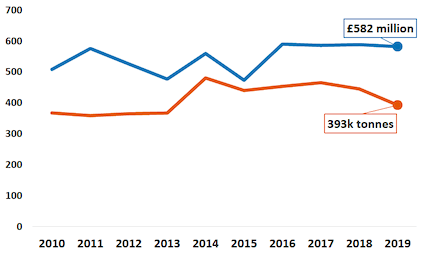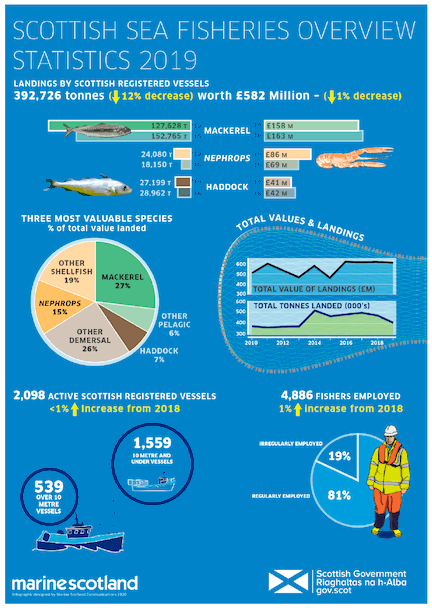Scottish Sea Fisheries Statistics 2019
National Statistics publication that provides data on the tonnage and value of all landings of sea fish and shellfish by Scottish vessels, all landings into Scotland, the rest of the UK and abroad, and the size and structure of the Scottish fishing fleet and employment on Scottish vessels.
2. Overview Statistics
2.1. Landings by Scottish vessels
In 2019, Scottish vessels landed 393 thousand tonnes of sea fish and shellfish with a gross value of £582 million. Compared to 2018 there was a small change in the real value of landings (one per cent decrease) and a 12 per cent decrease in the tonnage landed.
The decrease in real value was driven by demersal and pelagic species, as shellfish species increased in value. Demersal species were worth £191 million, a fall of seven per cent compared to 2018. Pelagic species decreased five per cent in value to £195 million. Shellfish value increased 10 per cent to £196 million.
Landings by Scottish vessels accounted for 60 per cent of the value and 62 per cent of the tonnage of all landings by UK vessels in 2019 (Table 22a, ). Compared to 2018, the Scottish share of the total UK value has increased by two percentage points and tonnage has decreased by one percentage point.
Mackerel remained the most valuable species landed by the Scottish fleet, representing 27 per cent of the value of all Scottish vessels’ landings. Nephrops is the second most valuable species, with 15 per cent of the total value. Haddock became the most valuable demersal species overtaking cod with monkfish third. Together, haddock, cod and monkfish account for 20 per cent of the value of Scottish vessels’ landings.
As shown in Chart 1, the general trend in the tonnage and value of landings over the past ten years is positive; tonnage has increased by 25,000 tonnes (seven per cent) and value in real terms has increased by £74 million (15 per cent) since 2010.

2.2. The Scottish fishing fleet
There were 2,098 active Scottish fishing vessels in 2019, an increase of 9 vessels from 2018. In 2019, the number of over ten metre vessels was 539, down 11 vessels (two per cent) from 2018. There were 1,559 vessels in the ten metre and under fleet, an increase of 20 vessels (one per cent) compared to 2018.
2.3. Employment
There were 4,886 fishers employed on Scottish registered vessels at the end of 2019. This figure is up one per cent (26 fishers) since 2018. Compared to 2018, there were 91 less regularly employed fishers (two per cent decrease), 86 more irregularly employed fishers (10 per cent increase) and 31 more crofters.

Contact
Email: fisheriesstatistics@gov.scot
There is a problem
Thanks for your feedback